Investigation of Corrosion and Fouling in a Novel Biocide-Free Antifouling Coating on Steel
Abstract
1. Introduction
2. Materials and Methods
2.1. Materials
2.2. Coating Preparation
2.2.1. Synthesis Procedure of the Antifouling Coating
2.2.2. Description of Synthesis Steps
Synthesis of Magnetite (Fe3O4) Nanoparticles (Comp.a1)
Synthesis of Aniline–Carboxylic Acid Dimer (C6H5NH2-COOH Dimer) (Comp.a2)
Synthesis of Aniline–Magnetite Monomer (Comp.a3)
Synthesis of Polyaniline (PAni) Nanorods Integrated with Magnetite (Fe3O4) Nanoparticles (Comp.A)
Synthesis of Graphene Oxide (GO) Sheets (Comp.b1)
Modified Graphene Oxide (GO) Sheets with Titania (TiO2) (Comp.B)
Synthesis of Antifouling Coating (AF Coating)
2.2.3. Characterization of Nanocomposites
2.2.4. Panel Preparation
3. Results
3.1. Microstructural and Morphological Characterization of the Nanocomposites
3.1.1. Characterization of Polyaniline (Pani)/Magnetite Nanocomposite (Fe3O4 NPs)
3.1.2. Characterization of Modified Graphene Oxide (GO) with Titanium Dioxide (TiO2)
3.1.3. Characterization of the Final Antifouling Coating
3.2. Corrosion Tests of Antifouling Coating
3.2.1. Static Immersion Tests
3.2.2. Potentiodynamic Polarization (PDS) Tests
3.2.3. Electrochemical Impedance Spectroscopy (EIS) Tests
3.3. On-Site Immersion of Steels in Real Seawater
4. Discussion
5. Conclusions
6. Patents
Author Contributions
Funding
Institutional Review Board Statement
Informed Consent Statement
Data Availability Statement
Acknowledgments
Conflicts of Interest
Abbreviations
| AF | antifouling |
| TBT | tributyltin |
| GO | graphene oxide |
| PAni | polyaniline |
| NPs | nanoparticles |
| DMF | dimethylformamide |
| ASW | artificial seawater |
| SEM | scanning electron microscopy |
| TEM | transmission electron microscopy |
| EIS | electrochemical impedance spectroscopy |
| PDP | potentiodynamic polarization |
| OCP | open circuit potential |
| RE | reference electrode |
| CE | counter electrode |
| WE | working electrode |
| SAED | Selected Area Electron Diffraction |
| n | corrosion inhibition efficiency |
| Rs | electrolyte resistance |
| Rct | charge transfer resistance |
| CPEdl | Double-layer capacitive phase element |
| CPEc | coating capacitance |
| Rc | coating resistance |
| FR | Foul Resistance |
| PDR | Physical Data Rating |
| OP | Overall Performance |
| ECORR | corrosion potential |
| ICORR | corrosion current density |
| βa | anodic Tafel slope |
| βc | cathodic Tafel slope |
| CR | corrosion rate |
| φ | volume percentage of water uptake |
References
- Jalaie, A.; Afshaar, A.; Mousavi, S.B.; Heidari, M. Investigation of the Release Rate of Biocide and Corrosion Resistance of Vinyl-, Acrylic-, and Epoxy-Based Antifouling Paints on Steel in Marine Infrastructures. Polymers 2023, 15, 3948. [Google Scholar] [CrossRef] [PubMed]
- Shi, X.; Liang, H.; Li, Y. Review of Progress in Marine Anti-Fouling Coatings: Manufacturing Techniques and Copper- and Silver-Doped Antifouling Coatings. Coatings 2024, 14, 1454. [Google Scholar] [CrossRef]
- Lloyd, G. Rules for Classification and Construction, In Ship Technology; Bulgarian Register of Shipping: Varna, Bulgaria, 2012. [Google Scholar]
- Chasse, K.R.; Scardino, A.J.; Swain, G.W. Corrosion and Fouling Study of Copper-Based Antifouling Coatings on 5083 Aluminum Alloy. Prog. Org. Coat. 2020, 141, 105555. [Google Scholar] [CrossRef]
- Castelli, F.; Delucchi, M.; Valenza, F.; Garaventa, F.; Faimali, M.; Turturro, T.; Benedetti, A. Behavior of Biocide-Free Foul Control Paints for Ships’ Hulls in the Immediate Proximity of ICCP Anodes. J. Coat. Technol. Res. 2024, 21, 383–399. [Google Scholar] [CrossRef]
- Liang, H.; Shi, X.; Li, Y. Technologies in Marine Antifouling and Anti-Corrosion Coatings: A Comprehensive Review. Coatings 2024, 14, 1487. [Google Scholar] [CrossRef]
- Kanthasamy, R.; Algarni, M.; Peng, L.C.; Zakaria, N.A.; Zwawi, M. The Effects of Solvent on Superhydrophobic Polyurethane Coating Incorporated with Hydrophilic SiO2 Nanoparticles as Antifouling Paint. Polymers 2023, 15, 1328. [Google Scholar] [CrossRef] [PubMed]
- Li, L.; Hong, H.; Cao, J.; Yang, Y. Progress in Marine Antifouling Coatings: Current Status and Prospects. Coatings 2023, 13, 1893. [Google Scholar] [CrossRef]
- Kumar, A.; Mishra, V.; Negi, S.; Kar, S. A Systematic Review on Polymer-Based Superhydrophobic Coating for Preventing Biofouling Menace. J. Coat. Technol. Res. 2023, 20, 1499–1512. [Google Scholar] [CrossRef]
- El-Wahab, H.A.; Al-Shareef, H.F. Novel Antifouling Paint Formulation Based on Ca2Cr2O5 and CaMnO3 NPs as a Protective Pigment. Sci. Rep. 2024, 14, 24474. [Google Scholar] [CrossRef] [PubMed]
- Monty, J.P.; Dogan, E.; Hanson, R.; Scardino, A.J.; Ganapathisubramani, B.; Hutchins, N. An Assessment of the Ship Drag Penalty Arising from Light Calcareous Tubeworm Fouling. Biofouling 2016, 32, 451–464. [Google Scholar] [CrossRef] [PubMed]
- Schultz, M.P.; Bendick, J.A.; Holm, E.R.; Hertel, W.M. Economic Impact of Biofouling on a Naval Surface Ship. Biofouling 2011, 27, 87–98. [Google Scholar] [CrossRef] [PubMed]
- Papadopoulos, N.; Vourna, P.; Falara, P.; Vourna, P. A Modern Approach Towards Efficient Antifouling Coating Technologies. Nanotechnol. Adv. Mater. Sci. 2023, 6, 1–4. [Google Scholar] [CrossRef]
- Falara, P.P.; Papadopoulos, N.D.; Vourna, P. Microstructure and Performance of Antibiofouling Coatings on High-Strength Steel Substrates Immersed in the Marine Environment. Micro 2022, 2, 277–294. [Google Scholar] [CrossRef]
- Thomas, M.C.; Waugh, G.; Vanwonterghem, I.; Webster, N.S.; Rinke, C.; Fisher, R.; Luter, H.M.; Negri, A.P. Protecting the Invisible: Establishing Guideline Values for Copper Toxicity to Marine Microbiomes. Sci. Total Environ. 2023, 904, 166658. [Google Scholar] [CrossRef] [PubMed]
- Soon, Z.Y.; Jung, J.-H.; Loh, A.; Yoon, C.; Shin, D.; Kim, M. Seawater Contamination Associated with In-Water Cleaning of Ship Hulls and the Potential Risk to the Marine Environment. Mar. Pollut. Bull. 2021, 171, 112694. [Google Scholar] [CrossRef] [PubMed]
- Wu, S.; Wu, S.; Xing, S.; Wang, T.; Hou, J.; Zhao, Y.; Li, W. Research Progress of Marine Anti-Fouling Coatings. Coatings 2024, 14, 1227. [Google Scholar] [CrossRef]
- Bagley, F.; Atlar, M.; Charles, A.; Anderson, C. The Use of Copper-Based Antifoulings on Aluminium Ship Hulls. Ocean. Eng. 2015, 109, 595–602. [Google Scholar] [CrossRef]
- Brooks, S.; Waldock, M. The Use of Copper as a Biocide in Marine Antifouling Paints. In Advances in Marine Antifouling Coatings and Technologies; Elsevier: Amsterdam, The Netherlands, 2009; pp. 492–521. ISBN 978-1-84569-386-2. [Google Scholar]
- Liu, D.; Shu, H.; Zhou, J.; Bai, X.; Cao, P. Research Progress on New Environmentally Friendly Antifouling Coatings in Marine Settings: A Review. Biomimetics 2023, 8, 200. [Google Scholar] [CrossRef] [PubMed]
- Cao, Z.; Cao, P. Research Progress on Low-Surface-Energy Antifouling Coatings for Ship Hulls: A Review. Biomimetics 2023, 8, 502. [Google Scholar] [CrossRef] [PubMed]
- Yang, C.-W.; Lee, M.-L.; Liu, W.-R.; Thairiyarayar, C.B.; Liu, W.-R.; Chen, T.-Y.; Lee, C.-Y. Conductive Additives Effects on NCA–LFMP Composite Cathode in Water-Based Binder for High-Safety Lithium-Ion Batteries. Micro 2023, 3, 739–748. [Google Scholar] [CrossRef]
- Alshibeh Alwattar, N.; Vacandio, F.; Vassalo, L.; Djenizian, T.; Coulomb, B.; Boudenne, J.-L. Effects of Mode of Preparation of Titanium Dioxide Nanotube Arrays on Their Photocatalytic Properties: Application to p-Nitroaniline Degradation. Micro 2023, 3, 369–381. [Google Scholar] [CrossRef]
- Ribeiro, B.; Offoiach, R.; Monteiro, C.; Morais, M.R.G.; Martins, M.C.L.; Pêgo, A.P.; Salatin, E.; Fedrizzi, L.; Lekka, M. Electrodeposition of Zn and Cu Nanoparticles into TiO2 Nanotubes on Ti6Al4V: Antimicrobial Effect against S. Epidermidis and Cytotoxicity Assessment. Micro 2024, 4, 97–116. [Google Scholar] [CrossRef]
- Whitehead, K.A.; Brown, M.; Caballero, L.; Lynch, S.; Edge, M.; Hill, C.; Verran, J.; Allen, N.S. Nano-Titania Photocatalysis and Metal Doping to Deter Fungal Growth on Outdoor and Indoor Paint Surfaces Using UV and Fluorescent Light. Micro 2025, 5, 5. [Google Scholar] [CrossRef]
- Vourna, P.; Papadopoulos, N.D.; Falara, P.P.; Hristoforou, E. Barkhausen Noise Emission of Naval Steel: The Impact of Seawater Corrosion Coverage and Depth. NDT E Int. 2025, 151, 103319. [Google Scholar] [CrossRef]
- Committee D-19. D 1141-52 Standard Specifications for Substitute Ocean Water. In Manual on Industrial Water and Industrial Waste Water; ASTM: West Conshohocken, PA, USA, 1960; pp. 398–399. ISBN 978-0-8031-6884-8. [Google Scholar]
- ASTM G31-21; Standard Practice for Laboratory Immersion Corrosion Testing of Metals. ASTM: West Conshohocken, PA, USA, 2004.
- IMAGE-PRO® DISCOVERY: The Enhanced Image Analysis Solution from the Image-Pro Family; Media Cybernetics: Rockville, MD, USA, 2020.
- Criado, M.; Martínez-Ramirez, S.; Bastidas, J.M. A Raman Spectroscopy Study of Steel Corrosion Products in Activated Fly Ash Mortar Containing Chlorides. Constr. Build. Mater. 2015, 96, 383–390. [Google Scholar] [CrossRef]
- Neff, D.; Bellot-Gurlet, L.; Dillmann, P.; Reguer, S.; Legrand, L. Raman Imaging of Ancient Rust Scales on Archaeological Iron Artefacts for Long-term Atmospheric Corrosion Mechanisms Study. J. Raman Spectrosc. 2006, 37, 1228–1237. [Google Scholar] [CrossRef]
- Das, S.; Hendry, M.J. Application of Raman Spectroscopy to Identify Iron Minerals Commonly Found in Mine Wastes. Chem. Geol. 2011, 290, 101–108. [Google Scholar] [CrossRef]
- Thibeau, R.J.; Brown, C.W.; Heidersbach, R.H. Raman Spectra of Possible Corrosion Products of Iron. Appl. Spectrosc. 1978, 32, 532–535. [Google Scholar] [CrossRef]
- Shi, J.; Ming, J.; Wu, M. Electrochemical Behavior and Corrosion Products of Cr-Modified Reinforcing Steels in Saturated Ca(OH)2 Solution with Chlorides. Cem. Concr. Compos. 2020, 110, 103587. [Google Scholar] [CrossRef]
- Zhang, H.; Kong, F.; Chen, Y.; Zhao, X.; Tang, Y.; Zuo, Y. Degradation of Two Anti-Corrosion and Anti-Fouling Coating Systems in Simulated Diurnal Cycling Immersion. Coatings 2023, 13, 389. [Google Scholar] [CrossRef]
- Xue, Y.; Wang, S.; Bi, P.; Zhao, G.; Jin, Y. Super-Hydrophobic Co–Ni Coating with High Abrasion Resistance Prepared by Electrodeposition. Coatings 2019, 9, 232. [Google Scholar] [CrossRef]
- ASTM D3623-78a(2020); ASTM 3626: Test Method for Testing Antifouling Panels in Shallow Submergence. D01 Committee ASTM International: West Conshohocken, PA, USA, 2020. [CrossRef]
- ASTM D6990-20; ASTM D 6990: Practice for Evaluating Biofouling Resistance and Physical Performance of Marine Coating Systems. D01 Committee ASTM International: West Conshohocken, PA, USA, 2020. [CrossRef]
- Song, S.; Latag, G.V.; Mondarte, E.A.Q.; Chang, R.; Hayashi, T. Experimental Characterization of Water Condensation Processes on Self-Assembled Monolayers Using a Quartz Crystal Microbalance with Energy Dissipation Monitoring. Micro 2022, 2, 513–523. [Google Scholar] [CrossRef]
- Oh, S.J.; Cook, D.C.; Townsend, H.E. Characterization of Iron Oxides Commonly Formed as Corrosion Products on Steel. Hyperfine Interact. 1998, 112, 59–66. [Google Scholar] [CrossRef]
- Alcántara, J.; Fuente, D.D.L.; Chico, B.; Simancas, J.; Díaz, I.; Morcillo, M. Marine Atmospheric Corrosion of Carbon Steel: A Review. Materials 2017, 10, 406. [Google Scholar] [CrossRef] [PubMed]
- Zouarhi, M. Bibliographical Synthesis on the Corrosion and Protection of Archaeological Iron by Green Inhibitors. Electrochem 2023, 4, 103–122. [Google Scholar] [CrossRef]
- Sherif, E.-S.M.; Erasmus, R.M.; Comins, J.D. In Situ Raman Spectroscopy and Electrochemical Techniques for Studying Corrosion and Corrosion Inhibition of Iron in Sodium Chloride Solutions. Electrochim. Acta 2010, 55, 3657–3663. [Google Scholar] [CrossRef]
- Misawa, T.; Hashimoto, K.; Shimodaira, S. The Mechanism of Formation of Iron Oxide and Oxyhydroxides in Aqueous Solutions at Room Temperature. Corros. Sci. 1974, 14, 131–149. [Google Scholar] [CrossRef]
- Dwivedi, D.; Lepková, K.; Becker, T. Carbon Steel Corrosion: A Review of Key Surface Properties and Characterization Methods. RSC Adv. 2017, 7, 4580–4610. [Google Scholar] [CrossRef]
- Cui, Z.; Chen, S.; Wang, L.; Man, C.; Liu, Z.; Wu, J.; Wang, X.; Chen, S.; Li, X. Passivation Behavior and Surface Chemistry of 2507 Super Duplex Stainless Steel in Acidified Artificial Seawater Containing Thiosulfate. J. Electrochem. Soc. 2017, 164, C856–C868. [Google Scholar] [CrossRef]
- Sherif, E.-S. A Comparative Study on the Electrochemical Corrosion Behavior of Iron and X-65 Steel in 4.0 Wt % Sodium Chloride Solution after Different Exposure Intervals. Molecules 2014, 19, 9962–9974. [Google Scholar] [CrossRef] [PubMed]
- Pusparizkita, Y.M.; Fardilah, V.A.; Aslan, C.; Jamari, J.; Bayuseno, A.P. Understanding of Low-Carbon Steel Marine Corrosion through Simulation in Artificial Seawater. Aimsmates 2023, 10, 499–516. [Google Scholar] [CrossRef]
- Lagerström, M.; Butschle, M.; Larsson, A.I.; Cachot, J.; Dam-Johansen, K.; Schackmann, M.; Le Bihanic, F. Investigation of Critical Copper Release Rates for Dose Optimization of Antifouling Coatings. Prog. Org. Coat. 2025, 198, 108928. [Google Scholar] [CrossRef]
- Sahoo, B.N.; Thomas, P.J.; Thomas, P.; Greve, M.M. Antibiofouling Coatings For Marine Sensors: Progress and Perspectives on Materials, Methods, Impacts, and Field Trial Studies. ACS Sens. 2025, 10, 1600–1619. [Google Scholar] [CrossRef] [PubMed]
- Kordas, G. Novel Antifouling and Self-Healing Eco-Friendly Coatings for Marine Applications Enhancing the Performance of Commercial Marine Paints. In Engineering Failure Analysis; Thanapalan, K., Ed.; IntechOpen: London, UK, 2020; ISBN 978-1-78985-945-4. [Google Scholar]
- Chen, Q.; Zhang, Z.; Qi, Y. Construction of a Novel Environmentally-Friendly Long-Term Antifouling Coating with a Double-Layer Structure Regulated by Phenylmethyl Silicone Oil and Verification of the Static Antifouling Performance of the Coating. Surf. Interfaces 2025, 56, 105519. [Google Scholar] [CrossRef]
- Zeng, Z.; Lillard, R.S.; Cong, H. Effect of Salt Concentration on the Corrosion Behavior of Carbon Steel in CO2 Environment. Corrosion 2016, 72, 805–823. [Google Scholar] [CrossRef] [PubMed]
- Ture, S.A.; Pattathil, S.D.; Zing, B.Z.; Abbaraju, V. Fluorescence Sensing of Some Important Nitroaromatic Compounds by Using Polyaniline Ag Composite. Micro 2023, 3, 224–238. [Google Scholar] [CrossRef]
- Ichikawa, M.; Otaki, M.; Goto, H. Polyaniline Hybrids with Biological Tissue, and Biological Polymers as Physiological—Electroactive Materials. Micro 2023, 3, 172–191. [Google Scholar] [CrossRef]
- Kharade, P.M.; Thombare, J.V.; Dhasade, S.S.; Deokar, S.S.; Salunkhe, D.J.; Tamboli, M.S.; Patil, S.S. Spongy-Network-like Polyaniline Thin Films as Electrodes for a Supercapacitor. Micro 2022, 2, 541–548. [Google Scholar] [CrossRef]
- Guo, Y.; Qi, Y.; Zhang, C.; Zhang, S.; Zhang, Z. The Effect of Conductive Polyaniline on the Anti-Fouling and Electromagnetic Properties of Polydimethylsiloxane Coatings. Polymers 2023, 15, 2944. [Google Scholar] [CrossRef] [PubMed]
- Ren, X.; Wang, X.; Yang, X.; Hu, M.; Xie, H.H.; Wang, C. Carbon Dots Modified PANI Nanocomposites in Acrylic Resin Coatings for Enhancing the Anticorrosion and Antifouling Properties. Polym. Compos. 2023, 44, 5121–5131. [Google Scholar] [CrossRef]
- Li, J.; Bi, J.; Wang, X.; Wang, H.; Huang, X.; Li, Y.; Wang, G. Antifouling and Anticorrosion Properties of Coatings Based on Polyaniline Doped with Dodecyl Benzene Sulfonic Acid. Int. J. Electrochem. Sci. 2022, 17, 22039. [Google Scholar] [CrossRef]
- Tian, S.; Zhang, J.; Liu, S.; Li, J.; Pu, J.; Hao, Y.; Ying, G.; Xue, Q.; Lu, G. An Integrated Anti-Fouling and Anti-Corrosion Coating Enabled by rGO/AgNPs and Amphiphilic Networks. Engineering 2024, 42, 223–234. [Google Scholar] [CrossRef]
- Smitha, V.S.; Swargy, A.; Digilarani, M.; Vimala, T.; Resmi, T.R. Antifouling Behavior of Titania–Silica-Reduced Graphene Oxide Nanocomposites as Coatings for Marine Applications. New J. Chem. 2024, 48, 16202–16214. [Google Scholar] [CrossRef]
- Luo, S.; Li, H.; Wu, M.; Tan, Y.; Liu, F.-Q. Promote the Controlled-Released of Cu Ions Using Galvanic Corrosion to Achieve High-Efficiency Antifouling Coating. Prog. Org. Coat. 2025, 200, 108990. [Google Scholar] [CrossRef]
- Korek, E.-M.; Teotia, R.; Herbig, D.; Brederlow, R. Electrochemical Impedance Spectroscopy for Ion Sensors with Interdigitated Electrodes: Capacitance Calculations, Equivalent Circuit Models and Design Optimizations. Biosensors 2024, 14, 241. [Google Scholar] [CrossRef] [PubMed]
- Chaudhari, S.; Patil, P.P. Inhibition of Nickel Coated Mild Steel Corrosion by Electrosynthesized Polyaniline Coatings. Electrochim. Acta 2011, 56, 3049–3059. [Google Scholar] [CrossRef]
- Brasher, D.M.; Kingsbury, A.H. Electrical Measurements in the Study of Immersed Paint Coatings on Metal. I. Comparison between Capacitance and Gravimetric Methods of Estimating Water-uptake. J. Appl. Chem. 1954, 4, 62–72. [Google Scholar] [CrossRef]
- Hartshorn, L.; Megson, N.J.L.; Rushton, E. The Structure and Electrical Properties of Protective Films. J. Soc. Chem. Ind. 1937, 56, 266–270. [Google Scholar]
- ISO 2812-2:2018; Paints and Varnishes—Determination of Resistance to Liquids Part 2: Water Immersion Method. ISO: Geneva, Switzerland, 2018.
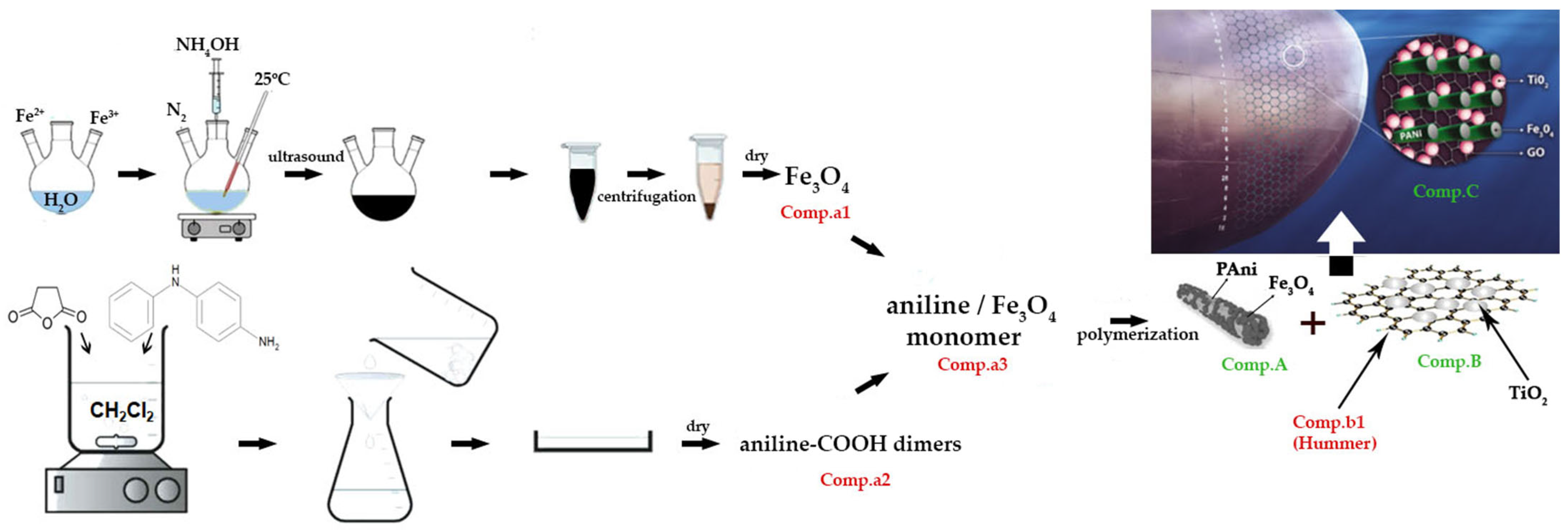

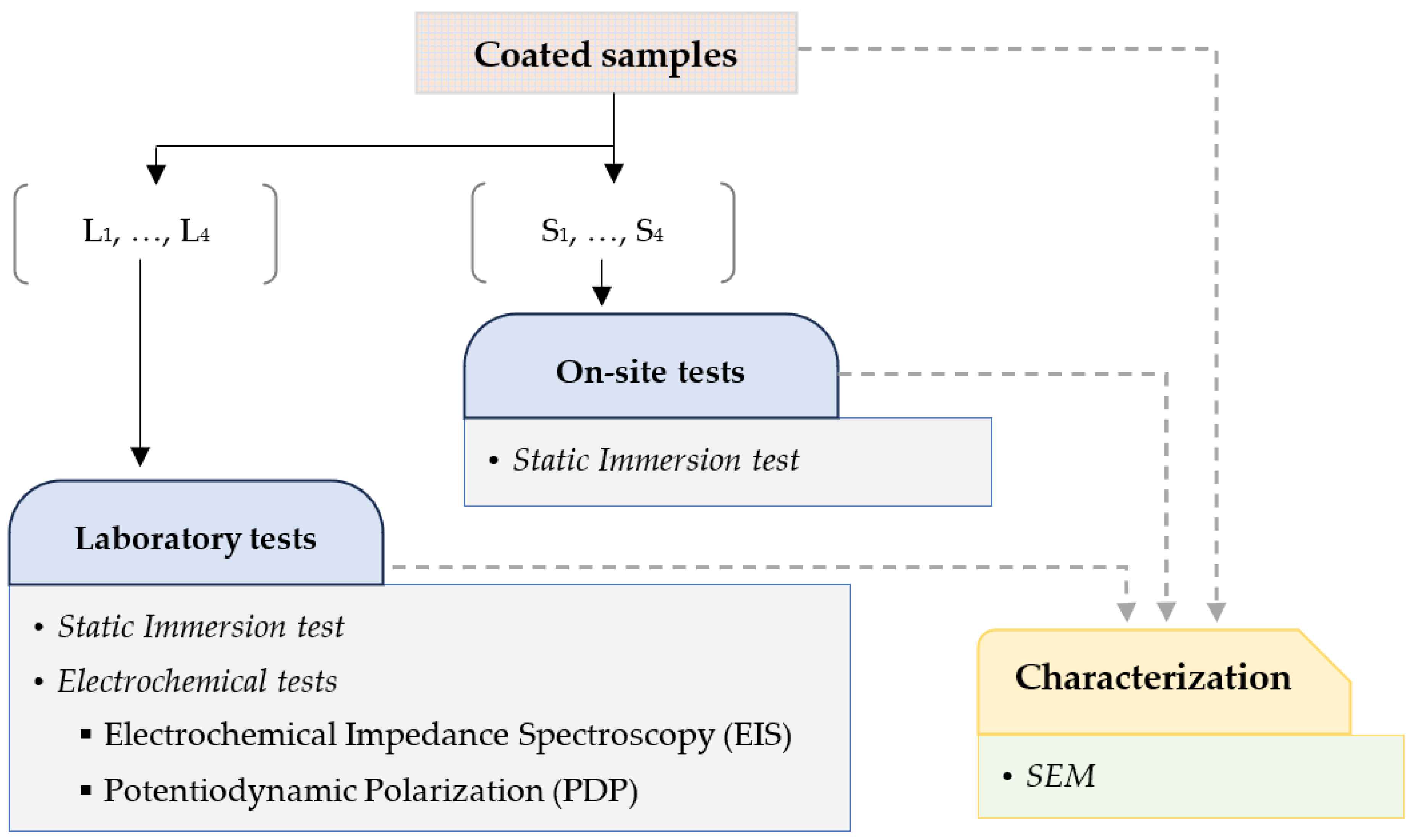
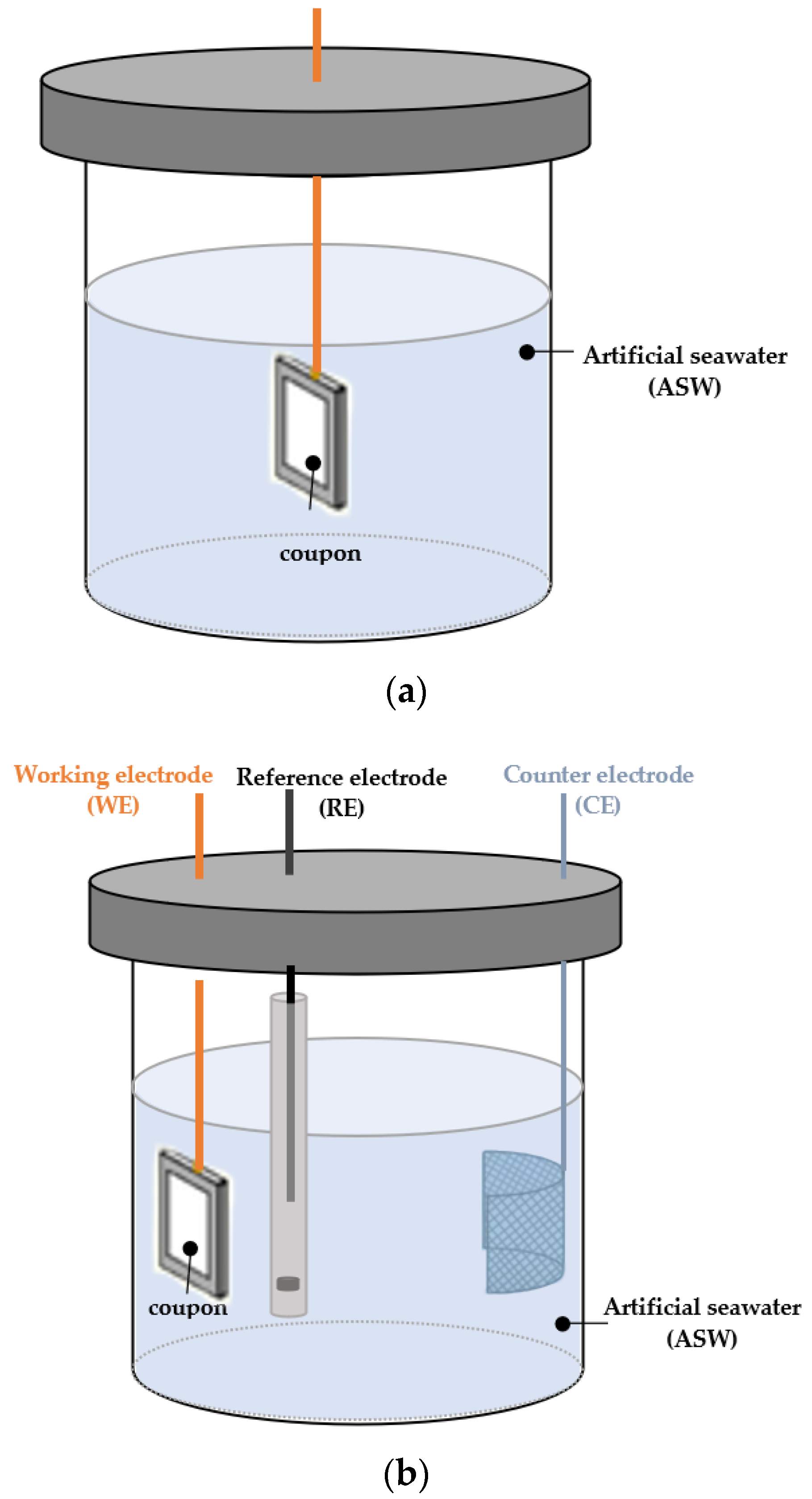






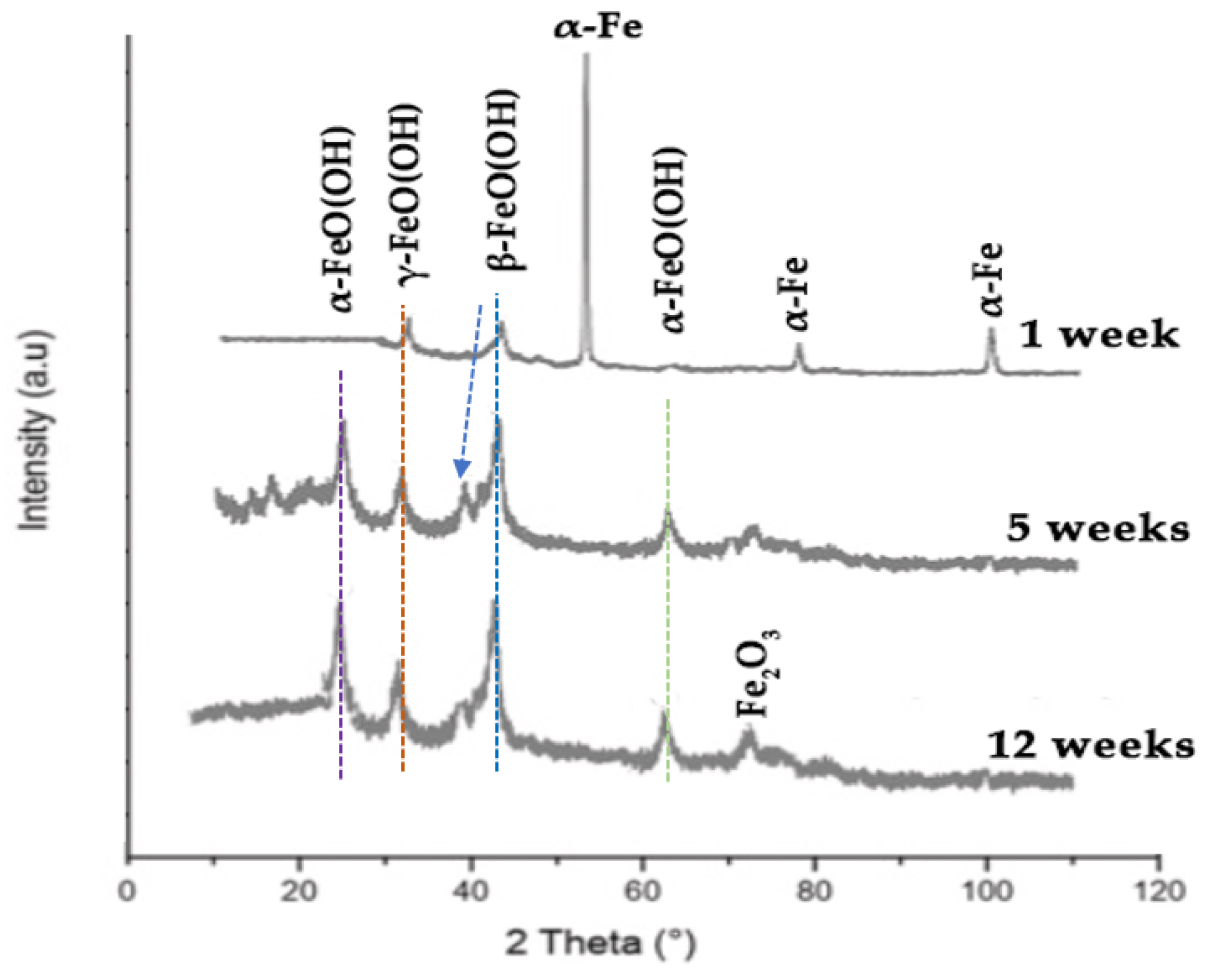

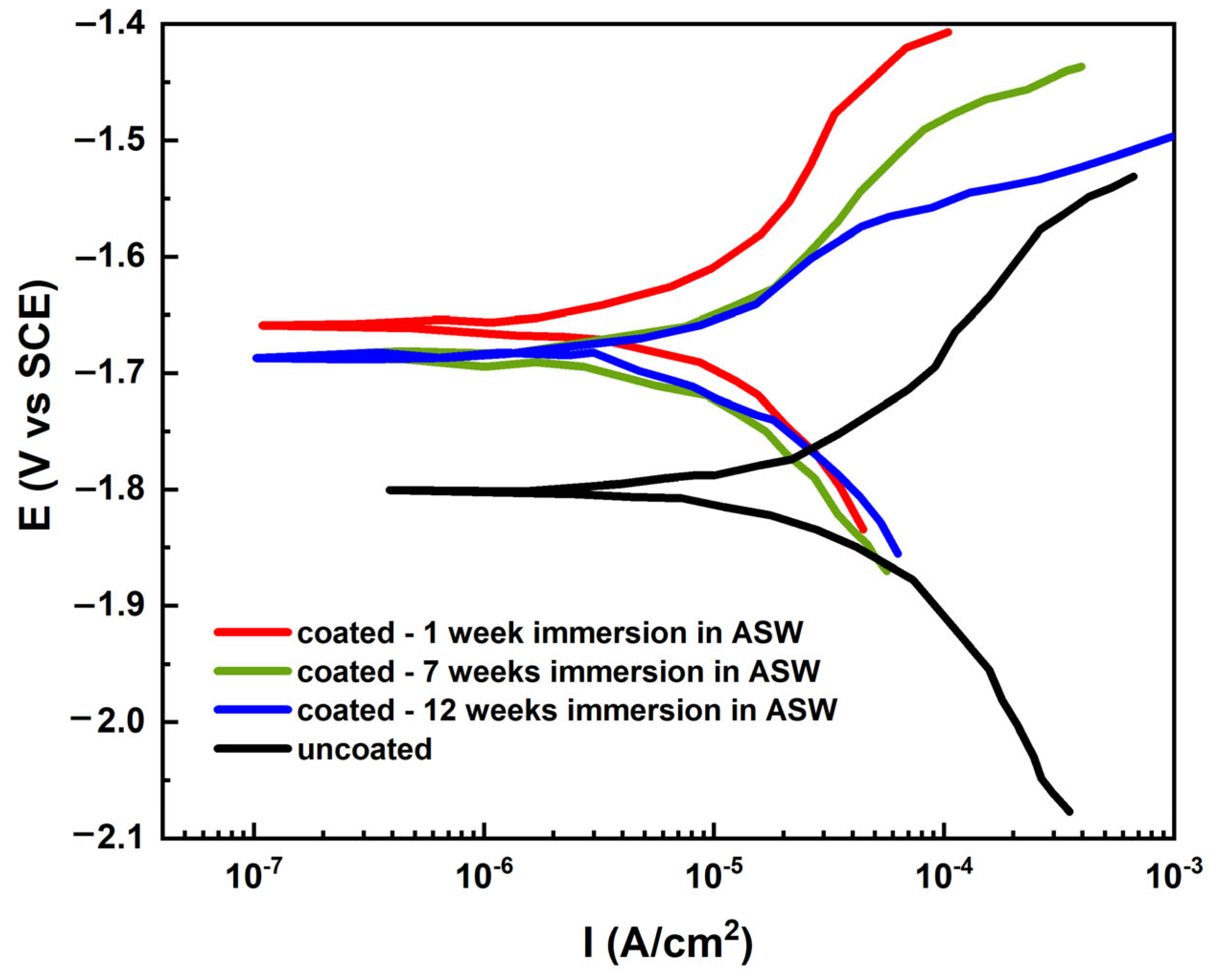
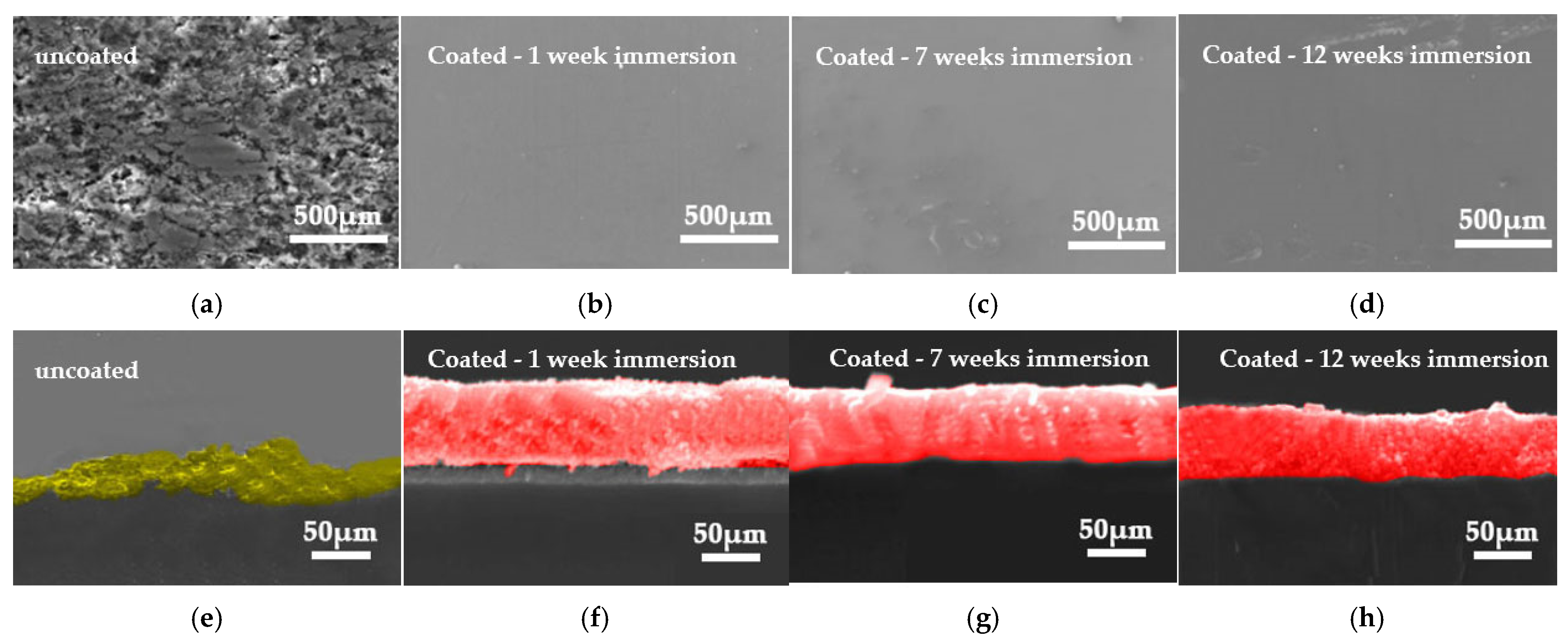

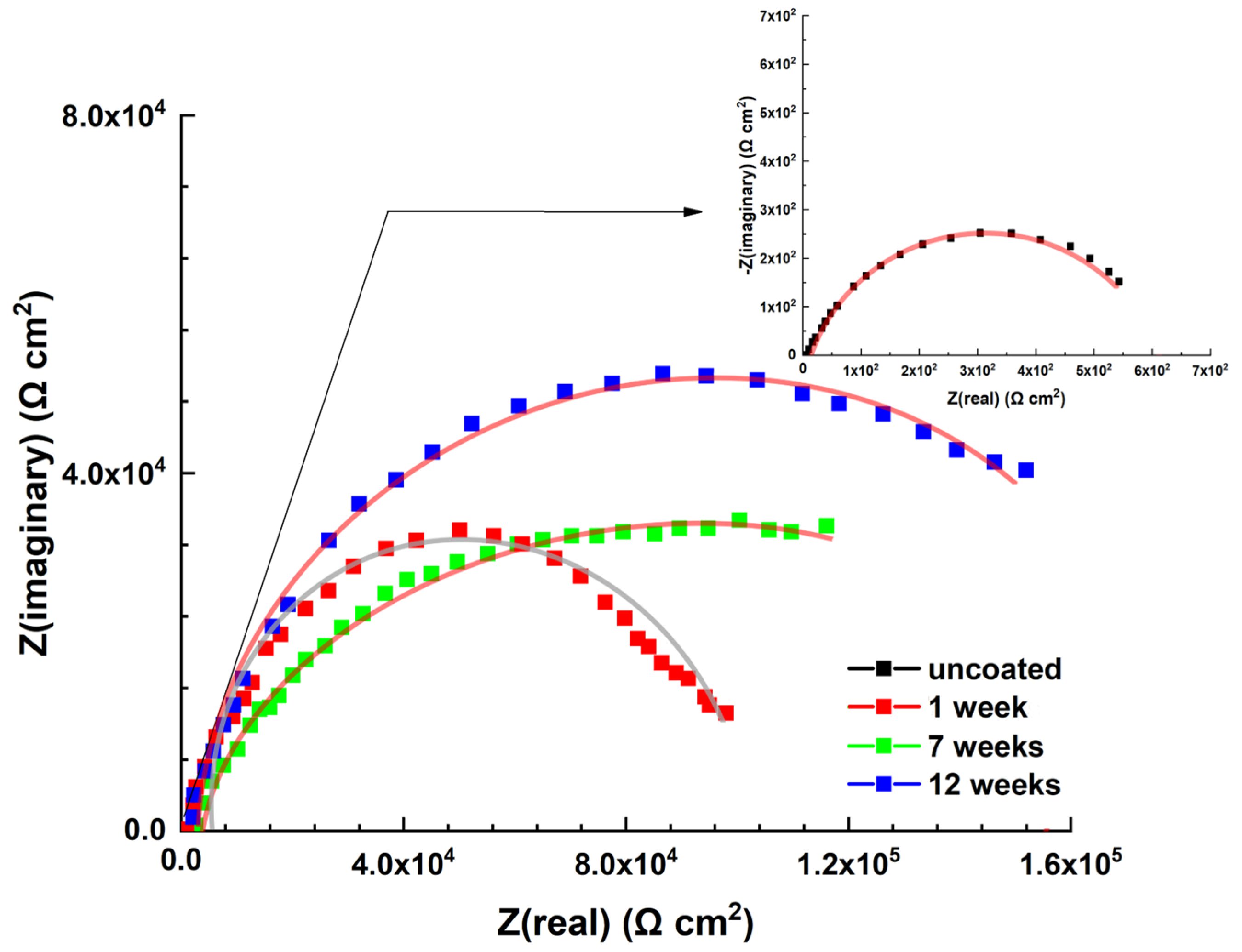
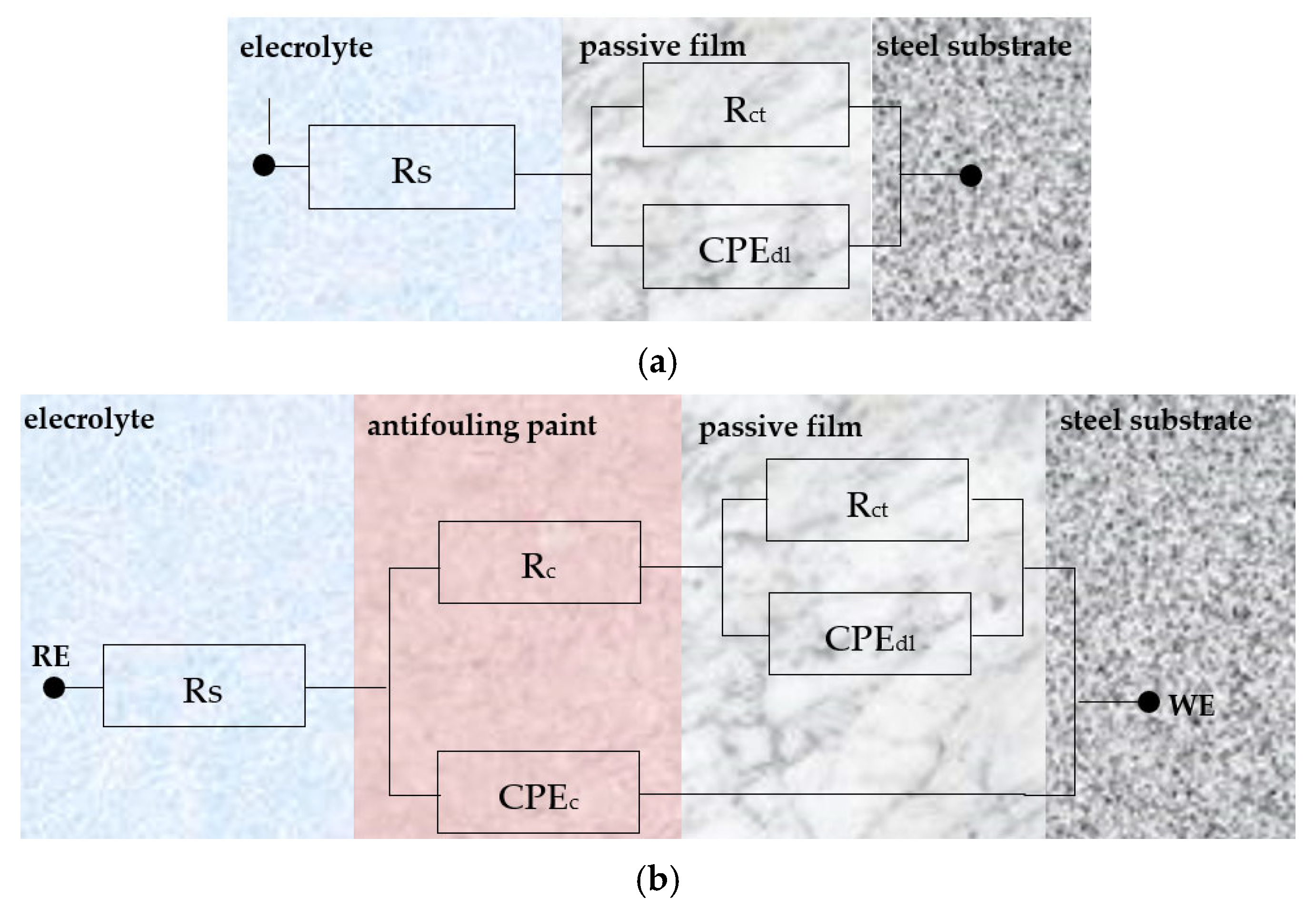
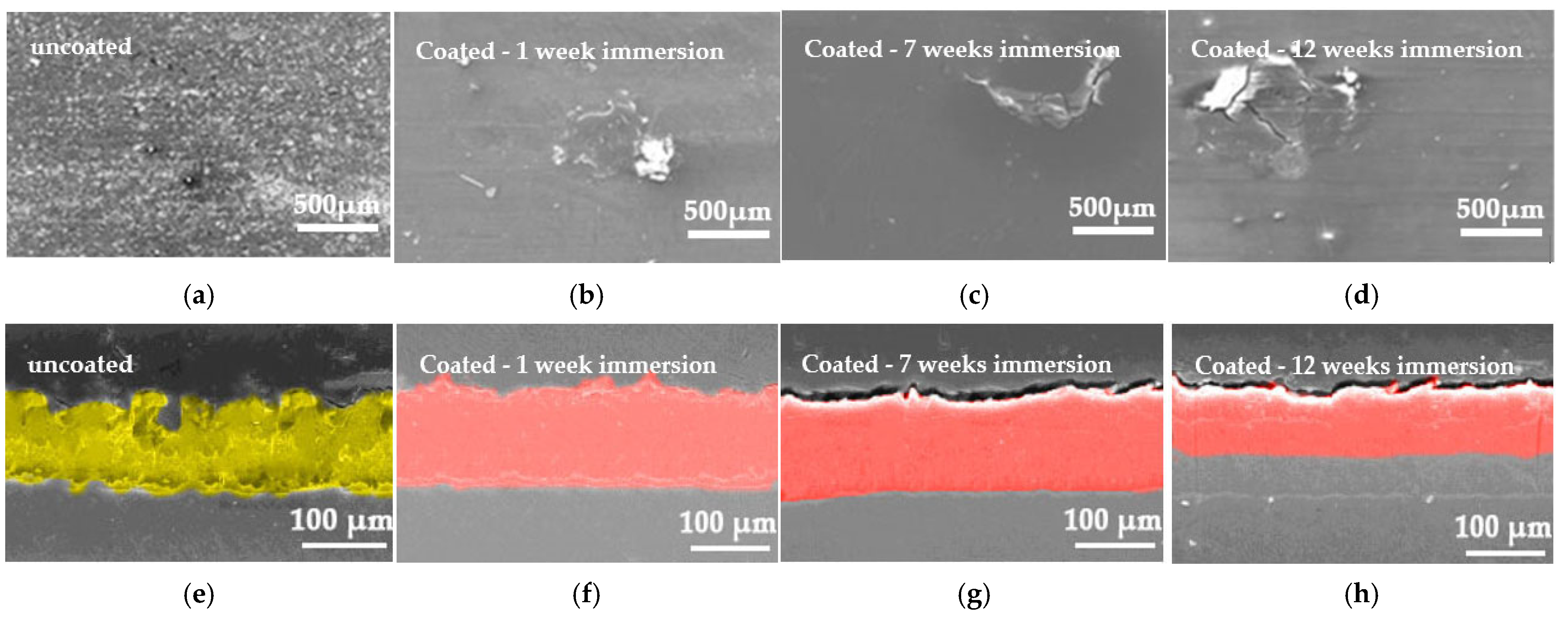
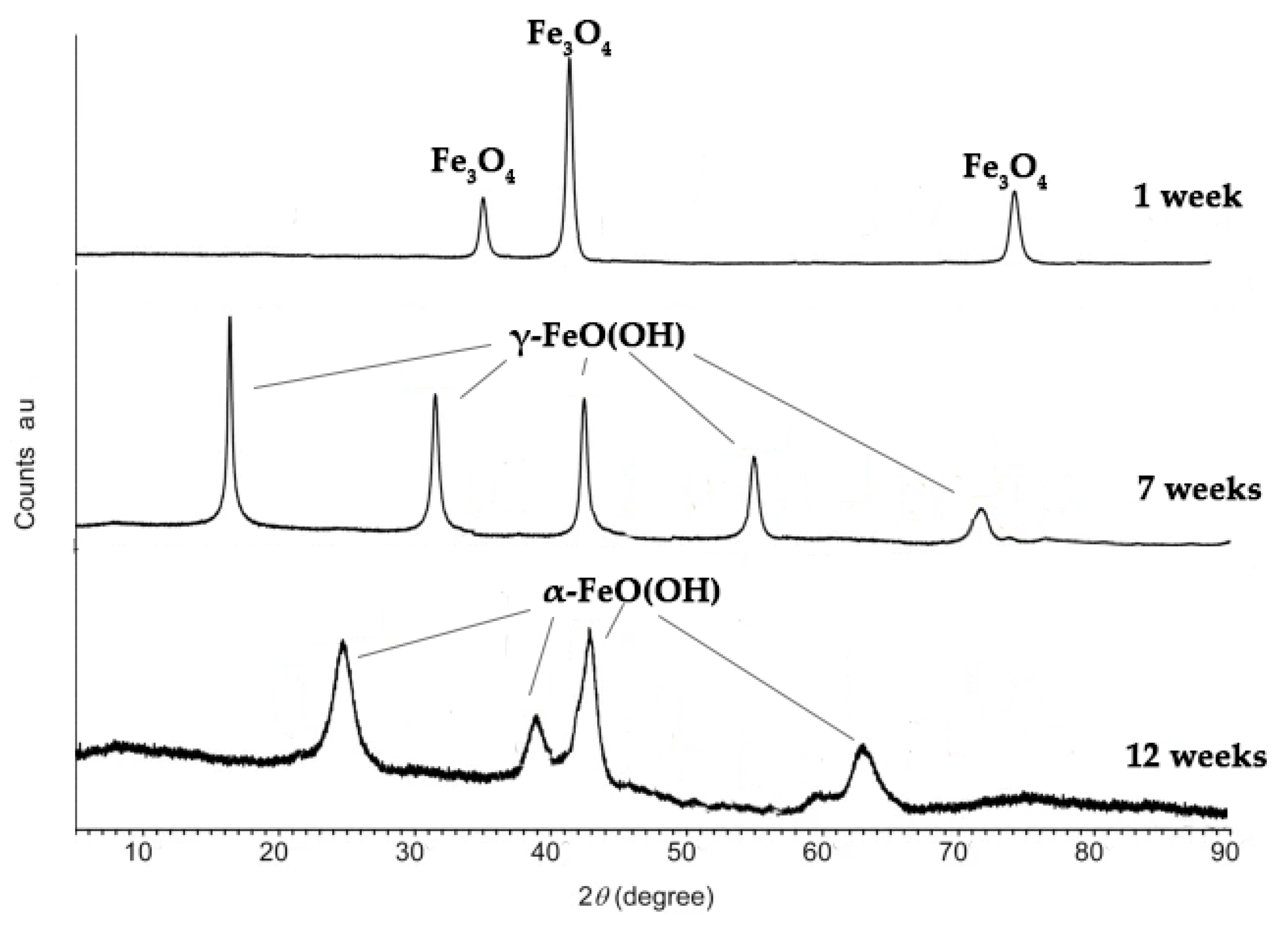
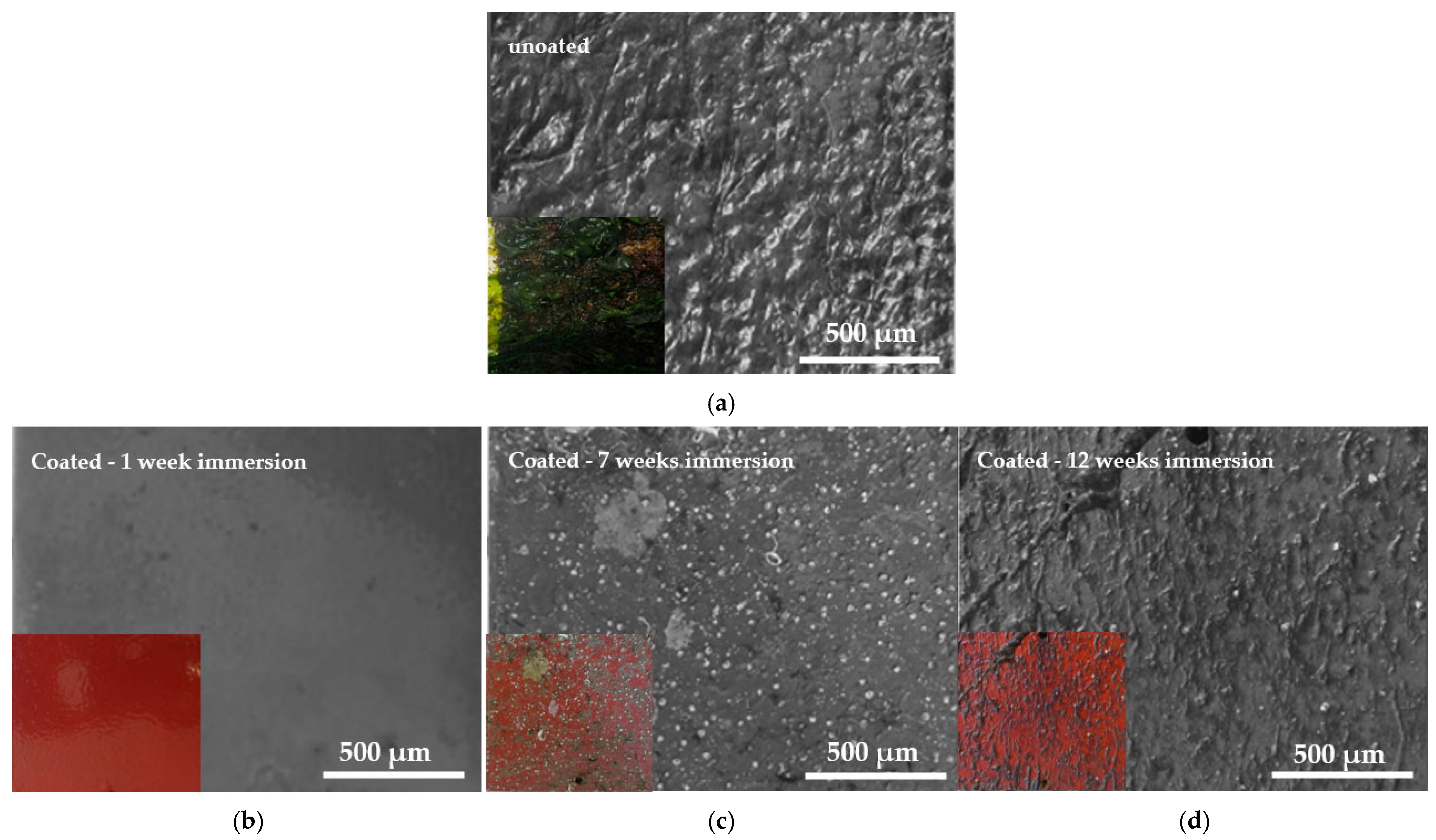

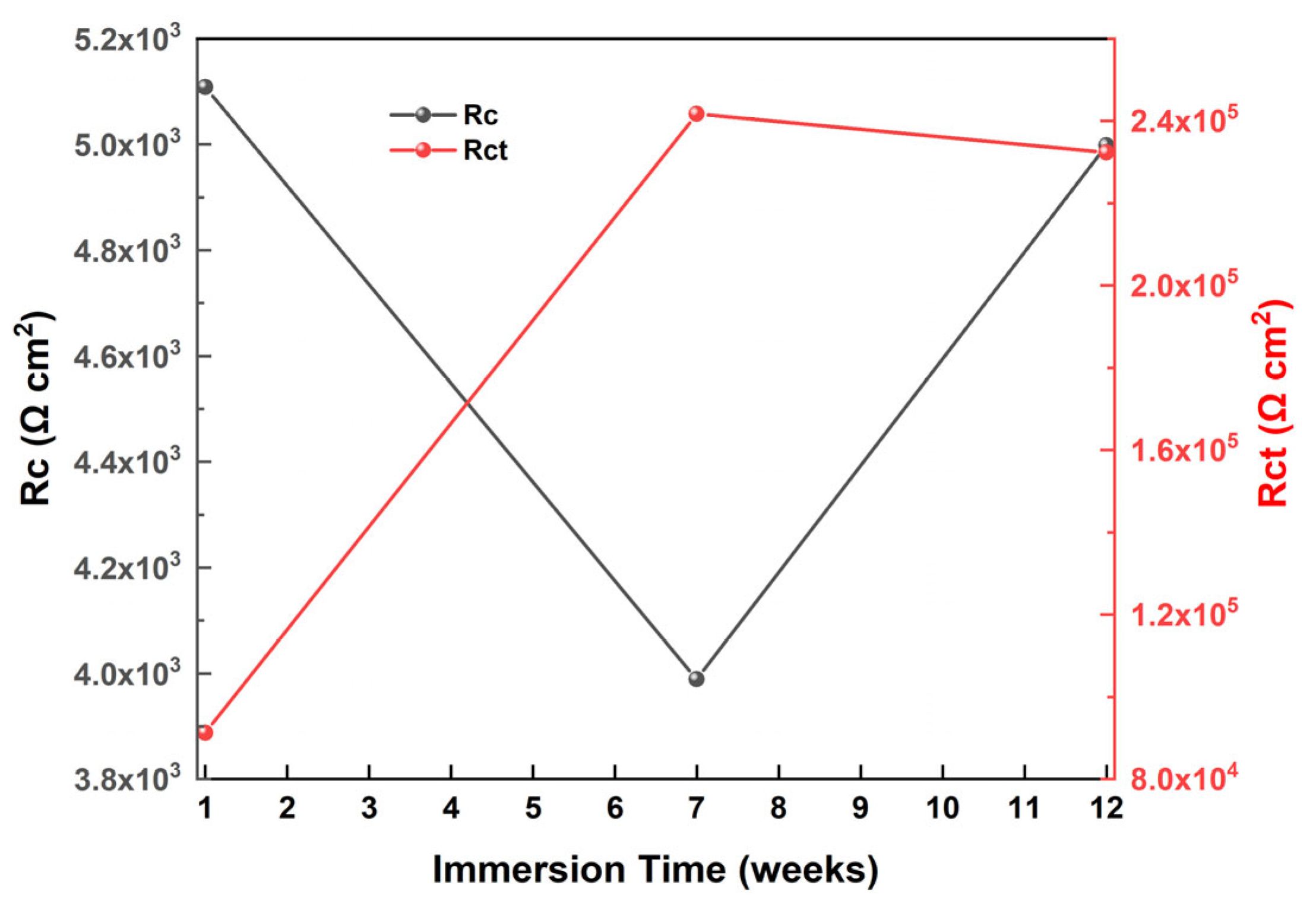
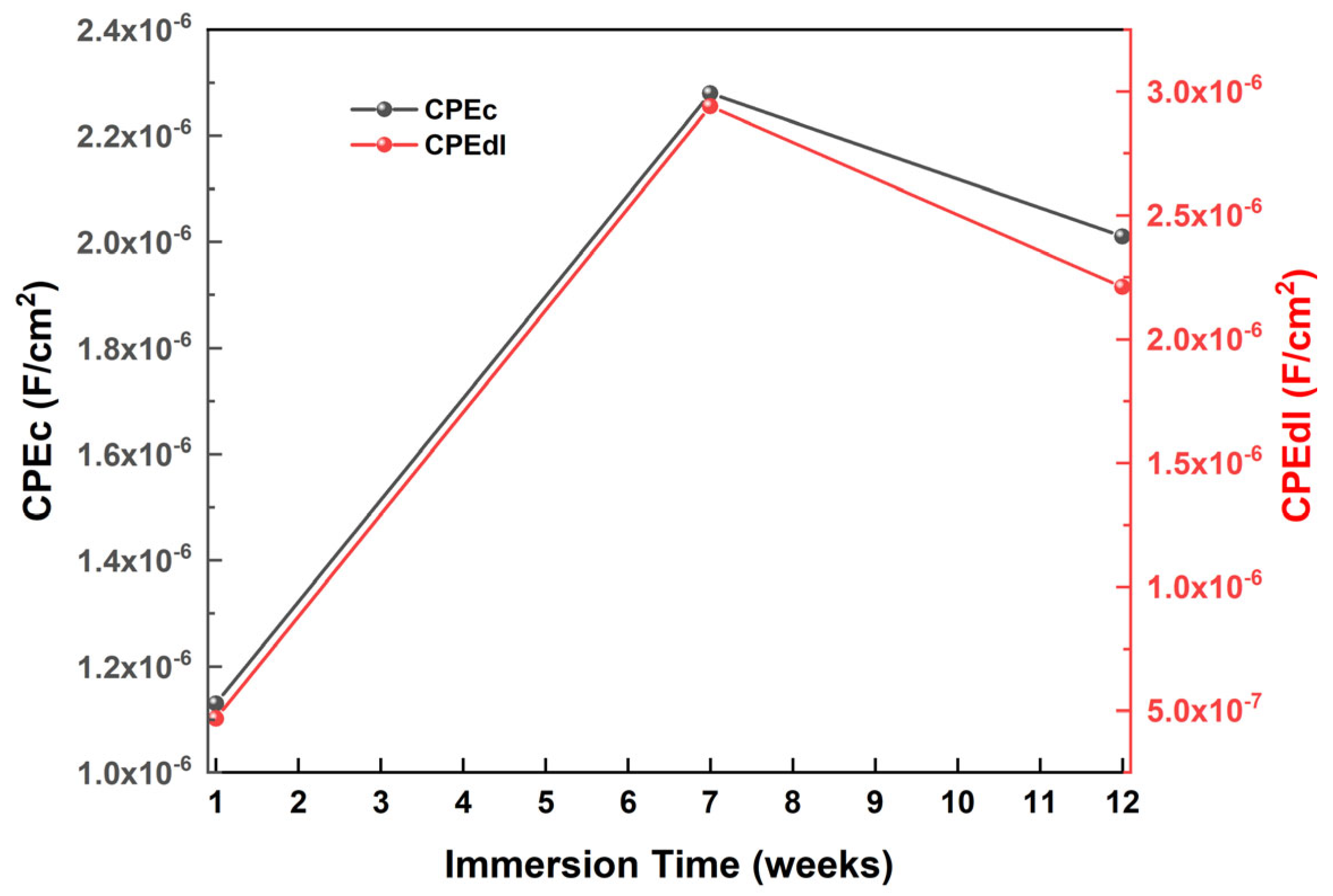


| Immersion Time (Weeks) | ECORR (V vs. SCE) | ICORR (µA/cm2) | Rp (Ω/cm2) |
|---|---|---|---|
| uncoated | −1.801 | 23.01 | 1121 |
| 1 | −1.659 | 4.03 | 6494 |
| 7 | −1.683 | 8.49 | 3072 |
| 12 | −1.684 | 7.52 | 3477 |
| Immersion Time (Weeks) | RS (Ω⬝cm2) | RC (Ω⬝cm2) | CPEC (F/cm2) | Rct (Ω ⬝ cm2) | CPEdl (F/cm2) |
|---|---|---|---|---|---|
| uncoated | 8.42 | - | - | 6.32 × 102 | 7.97 × 10−4 |
| 1 | 10.75 | 5108 | 1.13 × 10−6 | 91.32 × 103 | 4.68 × 10−7 |
| 7 | 23.82 | 3989 | 2.28 × 10−6 | 24.17 × 104 | 2.94 × 10−6 |
| 12 | 11.68 | 4998 | 2.01 ×10−6 | 23.23 × 104 | 2.21 × 10−6 |
| Immersion Time (Weeks) | FR (%) | PDR (%) | OP (%) |
|---|---|---|---|
| uncoated | 6.19 | 100 | 6.19 |
| 1 | 93.19 | 100 | 93.19 |
| 7 | 98.87 | 100 | 98.87 |
| 12 | 99.87 | 100 | 99.87 |
Disclaimer/Publisher’s Note: The statements, opinions and data contained in all publications are solely those of the individual author(s) and contributor(s) and not of MDPI and/or the editor(s). MDPI and/or the editor(s) disclaim responsibility for any injury to people or property resulting from any ideas, methods, instructions or products referred to in the content. |
© 2025 by the authors. Licensee MDPI, Basel, Switzerland. This article is an open access article distributed under the terms and conditions of the Creative Commons Attribution (CC BY) license (https://creativecommons.org/licenses/by/4.0/).
Share and Cite
Vourna, P.; Falara, P.P.; Papadopoulos, N.D. Investigation of Corrosion and Fouling in a Novel Biocide-Free Antifouling Coating on Steel. Micro 2025, 5, 34. https://doi.org/10.3390/micro5030034
Vourna P, Falara PP, Papadopoulos ND. Investigation of Corrosion and Fouling in a Novel Biocide-Free Antifouling Coating on Steel. Micro. 2025; 5(3):34. https://doi.org/10.3390/micro5030034
Chicago/Turabian StyleVourna, Polyxeni, Pinelopi P. Falara, and Nikolaos D. Papadopoulos. 2025. "Investigation of Corrosion and Fouling in a Novel Biocide-Free Antifouling Coating on Steel" Micro 5, no. 3: 34. https://doi.org/10.3390/micro5030034
APA StyleVourna, P., Falara, P. P., & Papadopoulos, N. D. (2025). Investigation of Corrosion and Fouling in a Novel Biocide-Free Antifouling Coating on Steel. Micro, 5(3), 34. https://doi.org/10.3390/micro5030034






